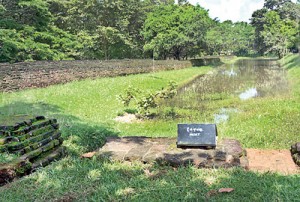History, legend and neglect lie side by side
In Panduwasnuwara you’ll catch a glimpse of history and folklore, woven so intricately together that it’s difficult to discern the difference between the two.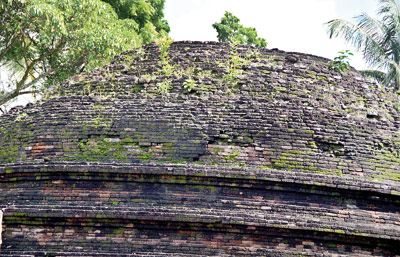
The 12th century kingdom temporarily occupied by King Parakramabahu I is more correctly identified as Parakramapura, but the locals (and visitors) stubbornly cling on to the old name, and the legendary tale of King Panduwasdev imprisoning his daughter Unmada Chithra-Rapunzel style-on a high tower at this location.
To get to Panduwasnuwara you must travel up to Wariyapola town, take the Chilaw road from there and about 13 km down this road you’ll encounter the Panduwasnuwara museum. Turn into the road by the museum to get to the site.
Panduwasnuwara was peaceful on the weekday we visited. An official from the Archaeology Department office nearby said that up to a thousand visitors sometimes arrive during weekends.
Although it is relatively little known in comparison to its grander, more vibrant successors, Panduwasnuwara marks an important turning point in Sri Lanka’s history.
This is where a young king–Parakramabahu I–first ruled when he became the ruler of Dakkinadesa–one of the three discrete kingdoms that the island had been portioned into.
Having succeeded his uncle Kirthi Sri Megha as the King of Dakkinadesa around 1140, Parakramabahu undertook the restoration of Anuradhapura, which had been destroyed by the Chola Army, and founded the administrative centre of Parakramapura; it was from here that he turned his attention to Polonnaruwa.
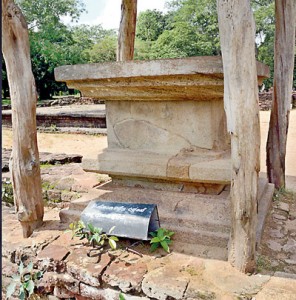
Inscription of King Nissankamalla’s visit to the royal palace
It was thus a temporary capital during his reign, and was also home briefly to the Sacred Tooth Relic. Later, Parakramabahu would go onto unify the island as its king, and oversee the expansion of his main capital Polonnaruwa.
Oral history will tell you that the city was founded by King Panduwasdev (512-474 BC), the nephew of Prince Vijaya. A large circular clearing further into the site is believed to have been the location for the ‘ektammaligawa’ (tower) in which he reportedly imprisoned his daughter Unmada Chithra when it was prophesied that her unborn son would kill his uncles to become king.
However, due to a lack of archaeological evidence this theory has not been confirmed, and the ruins of the site have been identified as belonging to the 12th century.
You can get to the main palace complex via a somewhat bumpy road that runs around it. The citadel’s thick, low walls (bordered by a moat) protect a palace complex that was originally painted white outside and red inside, complete with a courtyard and stage for the throne.
The ground plan of the palace is similar to King Parakramabahu’s Polonnaruwa palace. Here you’ll also find an inscription of King Nissankamalla’s visit to the Royal Palace near the stone seat, protected by a wooden canopy.
Other features of note include several well preserved examples of ancient drainage, monasteries with a bodhigara (a bo tree enclosed by brick), pilimage (image house) and stupas.
Unfortunately, all this magnificence lies in neglect. The road leading to Panduwasnuwara is bumpy, but what greets you upon arrival is more jarring.
The undergrowth is so thick and unruly in some places that trekking through it requires a certain amount of pluck, and the seasonal rains meant we were picking our way through muddy, marshy patches of ground.
Further, the ruins are not maintained-weeds and moss grow freely on these structures and a few signs (Check with Duvindi) are so faded that it is impossible to discern the lettering.

Invaded by overgrowth:Ruins of what is believed to be the ektammaligawa (above) and (inset) a moat
On a brighter note, we noticed several workers on the site engaged in clearing up activities. They were hesitant to speak to us, but a few inquiries revealed that the maintenance work was in preparation for a possible revamp of the area.
This is clearly overdue; in 2009 the cabinet granted approval to a memorandum submitted by the then Cultural Affairs and National Heritage Minister MahindaYapa Abeywardana, to launch a five-year conservation project of the Wayamba Quadrangle of which the estimated cost was Rs. 445 million.
Panduwasnuwara, along with the nearby kingdom of Yapahuwa, was due to benefit from this project.
The new venture, titled the Panduwasnuwara Master Plan Project, is still at the initial stages. Director, Project Planning and Monitoring Prasad Ranasinghe shared that the Department of Archaeology was currently discussing the project’s implementation.
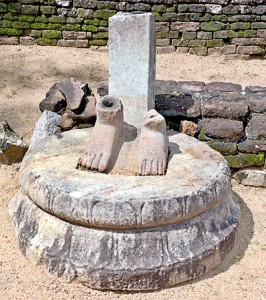
Remains of a statue
“We are keen to account for the concerns of those that live in close proximity to the site,” he noted. “We’re working alongside the Central Cultural Fund, the Road Development Authority and several other groups including civil organisations to ensure that no one is adversely affected by the project’s implementation.”
The Panduwasnuwara Master plan Project will be carried out over a period of five years and will target tourism promotion and the sustainable upkeep of the site, says Ranasinghe.
This will include the addition of a new information centre, upkeep of the existing Panduwasnuwara museum and a plan to make the site fully accessible to disabled visitors.
At the moment preliminary work, such as demarcation of boundaries and digging of trenches has begun. Alongside the direct involvement of the Central Cultural Fund, the department has also assumed the role of landscaping, conservation and excavation work.
Further, the project hopes to draw visitors to the nearby Panda Wewa (now known as KottambapitiyaWewa) and Nikathalanuwara, and direct revenue to the villagers who inhabit the area-in particular, by highlighting a ceramics industry-based community living next to the Panduwasnuwara site.
“We don’t want to isolate the villagers who live around the site,” says Ranasinghe. “We’re also hoping that the possibility of visiting other attractions in the area will encourage more visitors to come to Panduwasnuwara as well.”
The Sunday Times also spoke to Professor Nimal De Silva, President of the National Trust Sri Lanka. Professor De Silva was formerly the Director General of the Central Cultural Fund.
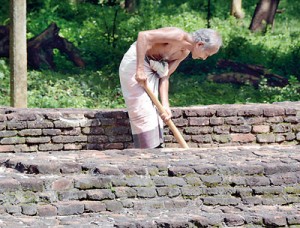
Positive signs of things to come? A workman clearing up
Panduwasnuwara falls under the purview of this authority which is responsible for managing and conserving all heritage sites in and around the Cultural Triangle (Panduwasnuwara belongs to the Wayamba Cultural Quadrangle).
Prof. De Silva noted, “the site has not yet been completely excavated and there is more to discover.” He feels that conservation work must focus on areas such as the bodhigara and image house, and on the palace complex as well. “These areas can certainly be uplifted,” he says.
The problem, he notes, is the lack of qualified conservation architects in the country. A poor incentive structure means that such professionals are too far and few, thus conservation work in Sri Lanka suffers as a result.
More attention must also be paid, we feel, for the day to day upkeep of heritage sites like Panduwasnuwara. The five-year plan sounds promising, but in the meantime those who visit must also be able to enjoy the history and culture of the city.
Whether this will involve empowering the villagers who live around the site- for whom the upkeep of Panduwasnuwara must be a vested interest- to carry out vigilance and minor maintenance activities is up to the relevant authorities.
